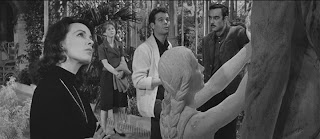Fig. 1 The Haunting Film Poster
Robert Wise 1963 film The Haunting is a classic psychological horror film that was leagues before its time. Making it much more than your usually ghost story becasuae of the several hidden themes that run though out such as loneliness, bereavement, family problems, the desire to be belong and to be wanted.
The Haunting was based on Shirley Jackson’s novel The Haunting of Hill House and the script was adapted by Nelson Gidding. The films follows Eleanor, Theodora and Luke arrive at the Hill House where they will be taking part in an experiment conducted by Dr Markway. The film is all about the unexplained and paranormal activity of Hill House which has a past history of violent accidents and mysterious that surrounds the house. The locals are cautious of house because of the stories that the house is haunted. In the beginning they just believe that they are just stories/tales that are told to scary them as no proof exists. But circumstances happen that are unexplainable like doors shutting on their own, colour spots, knocking and screaming noises. All are which the spirit of the house tormenting the group especially Eleanor who has this deep connection with the Hill House.
Fig. 2 The Haunting Film Still
Wise’s “The Haunting is a traditional ghost story. But, it isn’t a rattling chains and floating sheets affair; it’s an intelligent, thought-provoking tale.” (Romance, 2010) that relies on the imagination to provoke terror in the audience without using blood and gore. It’s the suspense of the unexplained that draws us into this film. It is the unseen, unexplained occurrences, the strange noises, and the mounting sense of terror, tension and dread. Wise shows how you don’t have to use the aid of visual representation to create a horror film but how to make the audience use their imagination to scary themselves.
Fig. 3 The Haunting Film Still
The Haunting truly lives up to its reputation with “The shocks that Robert Wise crafts in The Haunting are some of the most sophisticated and finely constructed ever placed on film.” (Scheib, 1999) The film is best known for the way that the ghosts are not actually seen but the way that they are suggested with what happens off camera. One way that a ghost is suggested is the way the doors close on the own. We do not actually see the door shut we only hear the door shut making the suggestion that there is a ghost because doors don’t shut on their own. Another great explain of how the use of suggestion is used is when Dr. Markway finds a cold spot by the door to the nursery. Automatically thinking of spirits and ghost because of the facts/stories that relate to them. The film scary parts come from the reaction to what happens off-camera making this film seems like a true ghost story that you’re told.
Fig. 4 The Haunting Film Still
Wise’s “plotline follows the standard haunted house scenario” (Valentin, 2005) which is the traditional theme that runs throughout many horror films but he has taken it to the next level. With the use of Gothic production design make the house feel uncanny and eerie to the viewer. The way the Wise’s filmed The haunting in black and white were as other films in 1963 were being filmed in colour. This was an interesting and perfect choice for this film making it unimportant that it was not in colour and intensify the atmosphere. Wise’s also makes the big decision on not actually uses a ghost but the sign’s that a ghost is there with the impressive camerawork that helps reinforces this. All of these things and much more are what made this film a classic and in a league before its time.
List of Illustrations
Figure 1. The Haunting (1963) The Haunting Film Poster. http://www.myuca.ucreative.ac.uk/webapps/portal/frameset.jsp?tab_tab_group_id=null&url=%2Fwebapps%2Fblackboard%2Fexecute%2Flauncher%3Ftype%3DCourse%26id%3D_13549_1%26url%3D (Accessed on 01/12/2010)
Figure 2. The Haunting (1963) The Haunting Film Still. http://staticmass.net/features/the-haunting-1963/ (Accessed on 01/12/2010)Figure 3. The Haunting (1963) The Haunting Film Still. http://chillingscenesofdreadfulvillainy.blogspot.com/2009_07_01_archive.html (Accessed on 01/12/2010)
Figure 4. The Haunting (1963) The Haunting Film Still. http://chillingscenesofdreadfulvillainy.blogspot.com/2009_07_01_archive.html (Accessed on 01/12/2010)
Bibliography
Romance, Voodoun (2010) Review of the film The Haunting. http://www.fatally-yours.com/horror-reviews/the-haunting-1963/ (Accessed on 01/12/2010)
Scheib, Richard (1999) The Haunting (Film Review) http://www.moria.co.nz/horror/haunting1963.htm (Accessed on 01/12/10)
Valentin, Mel (2005) The Haunting 1936 (Film Review).
http://www.movie-vault.com/reviews/the-haunting-1963/ (Accessed on 01/12/10)
Wes, R. (2008) The Haunting Film Review. http://www.oh-the-horror.com/page.php?id=127 (Accessed on 01/12/10)
Samuel, Patrick (2010) The Haunting (1963) & The Gothic. http://staticmass.net/features/the-haunting-1963/ (Accessed on 01/12/2010)





Well done, Sasha! Your 'housekeeping' is impeccable! This aspect of your creative work on the course is growing in confidence and sophistication all the time - keep at it, invest the time, and soon you'll get quicker, more confident and your analysis more rigorous. Soon, it will simply be the way you see the world and write it down - and then, you'll be able to write effectively on any subject. Great stuff!
ReplyDelete